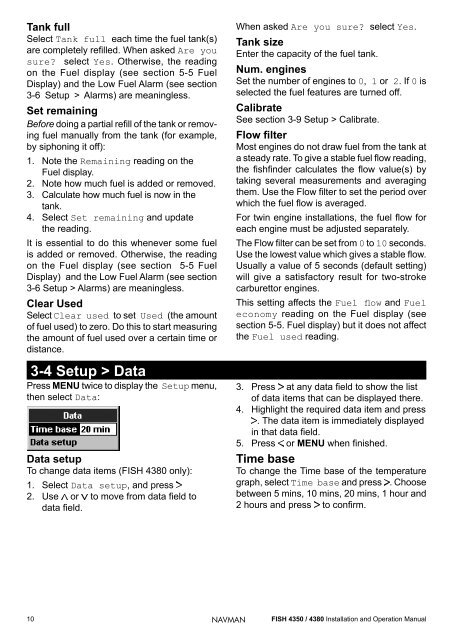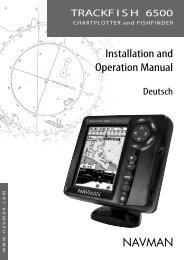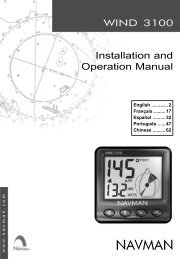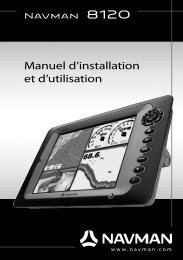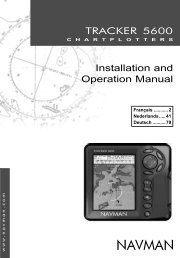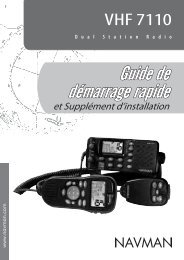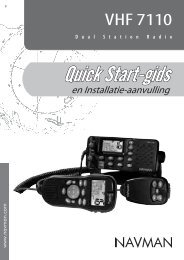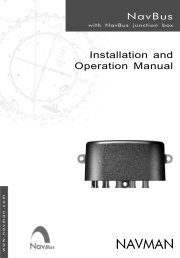English - Navman Marine
English - Navman Marine
English - Navman Marine
You also want an ePaper? Increase the reach of your titles
YUMPU automatically turns print PDFs into web optimized ePapers that Google loves.
Tank full<br />
Select Tank full each time the fuel tank(s)<br />
are completely reÞ lled. When asked Are you<br />
sure? select Yes. Otherwise, the reading<br />
on the Fuel display (see section 5-5 Fuel<br />
Display) and the Low Fuel Alarm (see section<br />
3 -6 Setup > Alarms) are meaningless.<br />
Set remaining<br />
Before doing a partial reÞll of the tank or removing<br />
fuel manually from the tank (for example,<br />
by siphoning it off):<br />
1. Note the Remaining reading on the<br />
Fuel display.<br />
2. Note how much fuel is added or removed.<br />
3. Calculate how much fuel is now in the<br />
tank.<br />
4. Select Set remaining and update<br />
the reading.<br />
It is essential to do this whenever some fuel<br />
is added or removed. Otherwise, the reading<br />
on the Fuel display (see section 5-5 Fuel<br />
Display) and the Low Fuel Alarm (see section<br />
3-6 Setup > Alarms) are meaningless.<br />
Clear Used<br />
Select Clear used to set Used (the amount<br />
of fuel used) to zero. Do this to start measuring<br />
the amount of fuel used over a certain time or<br />
distance.<br />
3-4 Setup > Data<br />
Press MENU twice to display the Setup menu,<br />
then select Data:<br />
Data setup<br />
To change data items (FISH 4380 only):<br />
1. Select Data setup, and press<br />
2. Use or to move from data Þ eld to<br />
data Þ eld.<br />
When asked Are you sure? select Yes.<br />
Tank size<br />
Enter the capacity of the fuel tank.<br />
Num. engines<br />
Set the number of engines to 0, 1 or 2. If 0 is<br />
selected the fuel features are turned off.<br />
Calibrate<br />
See section 3-9 Setup > Calibrate.<br />
Flow Þlter<br />
Most engines do not draw fuel from the tank at<br />
a steady rate. To give a stable fuel ßow reading,<br />
the Þ shÞ nder calculates the ß ow value(s) by<br />
taking several measurements and averaging<br />
them. Use the Flow Þ lter to set the period over<br />
which the fuel ß ow is averaged.<br />
For twin engine installations, the fuel ß ow for<br />
each engine must be adjusted separately.<br />
The Flow Þlter can be set from 0 to 10 seconds.<br />
Use the lowest value which gives a stable ß ow.<br />
Usually a value of 5 seconds (default setting)<br />
will give a satisfactory result for two-stroke<br />
carburettor engines.<br />
This setting affects the Fuel ßow and Fuel<br />
economy reading on the Fuel display (see<br />
section 5-5. Fuel display) but it does not affect<br />
the Fuel used reading.<br />
3. Press at any data Þ eld to show the list<br />
of data items that can be displayed there.<br />
4. Highlight the required data item and press<br />
. The data item is immediately displayed<br />
in that data Þ eld.<br />
5. Press or MENU when Þ nished.<br />
Time base<br />
To change the Time base of the temperature<br />
graph, select Time base and press . Choose<br />
between 5 mins, 10 mins, 20 mins, 1 hour and<br />
2 hours and press to conÞ rm.<br />
10 NAVMAN<br />
FISH 4350 / 4380 Installation and Operation Manual


